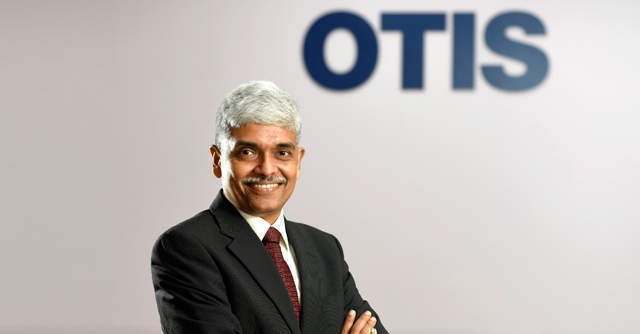
Otis India president Sebi Joseph on IoT making offices safer via smart elevators


With the worst of the pandemic behind us, enterprises are looking towards technologies, such as the Internet of Things (IoT), to make workplaces safe to return. And, smart elevators have become an integral part of this shift in building design in the post pandemic era.
The global smart elevator market is expected to grow from $18.75 billion in 2019 to $38.27 billion by 2027, at a compounded annual growth rate of 9.1% during the period, according to a September 2020 study by Fortune Business Insights.
A key player in this segment is Farmington, Connecticut based Otis, which also has a significant presence in India.

In an interview with TechCircle, Sebi Joseph, president of Otis India, explains the newest elevator technologies and how the company is utilizing mobile applications, IoT sensors, data analytics and AI to make buildings safer for people.
Otis has bet on touchless devices and applications. How has the adoption been in India?
India’s vertical transportation industry has been racing to adopt technologies related to IoT. And, it seems that emerging from Covid-19 is only going to accelerate that digital transformation.

Elevators play an essential role in keeping people safely on the move, every day. They are essentially the spine of the building and it’s almost impossible to not ride an elevator in a tall building; our customers recognize that. They have been very open to adopting our touchless technologies as it provides them with a renewed assurance to ride the elevators without worrying about the spread of the virus.
Further, Otis commissioned an elevator airflow study to determine how it affects the relative risk of transmission of the Covid-19 virus among passengers, and how to mitigate those risks through science-based safety protocols. We sought a leading expert on indoor air quality, Dr. Yan Chen from Purdue University, to lead the study to provide answers for customers and passengers.
Read: Infosys implements SAP HANA for Irish smart building solutions provider

How does Otis use technology to increase elevator safety?
At Otis, we’re in the life safety business and we put people at the core of everything we do. We are helping customers around the world prepare for the safe reopening and continued maintenance of their buildings.
From my perspective, touchless technologies are especially attractive options in this current environment.

One example of our touchless technology is the Otis eCall app. The app enables passengers to use their cell phone as their personal elevator call, button and users can e-Call an elevator when approaching it. This helps minimize use of public access elevator buttons. The eCall app also gives building managers the flexibility to provide easy access for passengers.
Beyond eCall, Otis offers its CompassPlus destination dispatching system. The system assigns passengers to a specific elevator, often grouping those travelling to nearby floors. This can help reduce car crowding and decrease travel times.
How does Otis utilize sensors, real time data to provide information to service teams and customers?

Otis is undergoing a global service transformation that is largely focused on empowering its service teams as well as customers with more information and communication.
Otis is doing that by providing field professionals with iPhones to increase efficiency, placing sensors on elevators that can collect data to offer real time updates on the elevator’s performance, and providing customers/managers access to transparent and real-time data on their elevator’s performance.
This same information is tied to apps used by field professionals. Instead of receiving a service call and arriving with little information, they will be notified about the issue and have a better understanding of potential solutions.

Additional equipment performance insights for field professionals can help them arrive on site ready with the tools and parts needed to get equipment up and running faster.
Which technologies are used in these elevator systems?
We are harnessing the power of data analytics, machine learning and cloud computing to understand elevator health and prescribe service. Otis ONE is our IoT platform and last year we added approximately 100,000 Otis ONE units globally as planned, bringing us to approximately 540,000 connected units. Over the medium term, we plan to accelerate portfolio connectivity to approximately 60 percent of units.
How do you see smart elevator business growing in India?
When you take a closer look at India, it is one of the fastest growing economies in the world. The Oxford Economics’ Global cities report estimates that 17 of the 20 fastest-growing cities in the world between 2019 and 2035 will be from India.
Studies have also shown that Indian cities are likely to contribute to 70% of India’s GDP by 2030. This means that as cities accommodate even more people, we will need more buildings and taller ones at that, as land in cities become scarce.
With this, India according to independent analysts, is the second-largest market for elevators and escalators in the world. The country is undergoing long-term urbanization and its infrastructure is growing accordingly.
Could you provide a case study of Otis’ most recent implementation?
From office buildings to railway stations, companies in the vertical transportation industry are supporting a broad array of projects across the country. For example, last year Otis India was selected to provide over 100 Gen2 elevators for the second phase of the Bengaluru Metro project, which is expected to be India’s third longest metro network once complete.
There is much left to be done within the Indian elevator and escalator industry. One of the larger focuses that will continue is towards strengthening local manufacturing and making factories here future ready for imports.
The industry is well-positioned, backed by macro trends such as urbanization and digitalization. The runway for India’s elevator industry is long and the scope to grow is immense.
